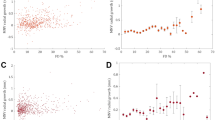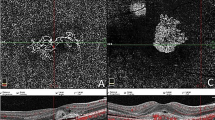Abstract
Purpose
To analyze the evolution of type 3 neovascularization in eyes with age-related macular degeneration during anti-vascular endothelial growth factor (VEGF) treatment using optical coherence tomography angiography (OCTA) analysis.
Methods
Forty-one treatment-naïve eyes (37 patients) with type 3 neovascularization were retrospectively included in the study. The growth and morphological changes in the type 3 lesions, which were recorded using OCTA, were compared across time.
Results
The high-flow signal of the lesion on OCTA was significantly increased at the sub-retinal pigment epithelium (RPE) and the choriocapillaris during anti-VEGF treatment. The detection rate of the flow signal in the sub-RPE increased from 50.0% at baseline and 51.2% at 12 months to 65.9% at 24 months (P = 0.013). The flow signal extending into the choriocapillaris was detected in 0% of the eyes at baseline, 9.8% of the eyes at 12 months, and 17.1% of the eyes at 24 months (P = 0.018). The presence of subretinal drusenoid deposits (SDD) was significantly more frequent in the group with extension into the choriocapillaris (100%) than in the group without (61.8%, P = 0.036). For the four eyes with extension into the choroid, the morphological feature of the lesion on en face OCTA evolved into a tangled vascular network, similar to type 1 neovascularization.
Conclusion
OCTA analysis revealed that type 3 neovascularization gradually extended downward toward the sub-RPE and choroid during anti-VEGF treatment. The extension of the lesion into the choriocapillaris, suggesting retinal-choroidal anastomosis, was significantly more frequent in eyes with SDD.



Similar content being viewed by others
Data availability
The data are available from the corresponding author upon reasonable request.
References
Freund KB, Ho IV, Barbazetto IA, Koizumi H, Laud K, Ferrara D, Matsumoto Y, Sorenson JA, Yannuzzi L (2008) Type 3 neovascularization: the expanded spectrum of retinal angiomatous proliferation. Retina 28:201–211. https://doi.org/10.1097/IAE.0b013e3181669504
Campochiaro PA (2012) Gene transfer for ocular neovascularization and macular edema. Gene Ther 19:121–126. https://doi.org/10.1038/gt.2011.164
Querques G, Souied EH, Freund KB (2015) How has high-resolution multimodal imaging refined our understanding of the vasogenic process in type 3 neovascularization? Retina 35:603–613. https://doi.org/10.1097/IAE.0000000000000487
Nagiel A, Sarraf D, Sadda SR, Spaide RF, Jung JJ, Bhavsar KV, Ameri H, Querques G, Freund KB (2015) Type 3 neovascularization: evolution, association with pigment epithelial detachment, and treatment response as revealed by spectral domain optical coherence tomography. Retina 35:638–647. https://doi.org/10.1097/IAE.0000000000000488
Li M, Dolz-Marco R, Messinger JD, Wang L, Feist RM, Girkin CA, Gattoussi S, Ferrara D, Curcio CA, Freund KB (2018) Clinicopathologic correlation of anti-vascular endothelial growth factor-treated type 3 neovascularization in age-related macular degeneration. Ophthalmology 125:276–287. https://doi.org/10.1016/j.ophtha.2017.08.019
Tan AC, Dansingani KK, Yannuzzi LA, Sarraf D, Freund KB (2017) Type 3 neovascularization imaged with cross-sectional and en face optical coherence tomography angiography. Retina 37:234–246. https://doi.org/10.1097/IAE.0000000000001343
Coscas GJ, Lupidi M, Coscas F, Cagini C, Souied EH (2015) Optical coherence tomography angiography versus traditional multimodal imaging in assessing the activity of exudative age-related macular degeneration: a new diagnostic challenge. Retina 35:2219–2228. https://doi.org/10.1097/IAE.0000000000000766
Miere A, Querques G, Semoun O, El Ameen A, Capuano V, Souied EH (2015) Optical coherence tomography angiography in early type 3 neovascularization. Retina 35:2236–2241. https://doi.org/10.1097/IAE.0000000000000834
Kuehlewein L, Dansingani KK, de Carlo TE, Bonini Filho MA, Iafe NA, Lenis TL, Freund KB, Waheed NK, Duker JS, Sadda SR, Sarraf D (2015) Optical coherence tomography angiography of type 3 neovascularization secondary to age-related macular degeneration. Retina 35:2229–2235. https://doi.org/10.1097/IAE.0000000000000835
Xu D, Davila JP, Rahimi M, Rebhun CB, Alibhai AY, Waheed NK, Sarraf D (2018) Long-term progression of type 1 neovascularization in age-related macular degeneration using optical coherence tomography angiography. Am J Ophthalmol 187:10–20. https://doi.org/10.1016/j.ajo.2017.12.005
Pilotto E, Frizziero L, Daniele AR, Convento E, Longhin E, Guidolin F, Parrozzani R, Cavarzeran F, Midena E (2018) Early OCT angiography changes of type 1 CNV in exudative AMD treated with anti-VEGF. Br J Ophthalmol. https://doi.org/10.1136/bjophthalmol-2017-311752
Cho HJ, Hwang HJ, Kim HS, Han JI, Lee DW, Kim JW (2017) Intravitreal aflibercept and ranibizumab injections for type 3 neovascularization. Retina. https://doi.org/10.1097/IAE.0000000000001862
Su D, Lin S, Phasukkijwatana N, Chen X, Tan A, Freund KB, Sarraf D (2016) An updated staging system of type 3 neovascularization using spectral domain optical coherence tomography. Retina 36(Suppl 1):S40–S49. https://doi.org/10.1097/IAE.0000000000001268
Campbell JP, Zhang M, Hwang TS, Bailey ST, Wilson DJ, Jia Y, Huang D (2017) Detailed vascular anatomy of the human retina by projection-resolved optical coherence tomography angiography. Sci Rep 7:42201. https://doi.org/10.1038/srep42201
Han JW, Cho HJ, Kang DH, Jung SH, Park S, Kim JW (2019) Changes in optical coherence tomography angiography and disease activity in type 3 neovascularization after anti-vascular endothelial growth factor treatment. Retina. https://doi.org/10.1097/IAE.0000000000002562
Spaide RF, Fujimoto JG, Waheed NK, Sadda SR, Staurenghi G (2018) Optical coherence tomography angiography. Prog Retin Eye Res 64:1–55. https://doi.org/10.1016/j.preteyeres.2017.11.003
Kim JM, Cho HJ, Kim Y, Jung SH, Lee DW, Kim JW (2019) Responses of types 1 and 2 neovascularization in age-related macular degeneration to anti-vascular endothelial growth factor treatment: optical coherence tomography angiography analysis. Semin Ophthalmol 34:168–176. https://doi.org/10.1080/08820538.2019.1620791
Spaide RF (2019) New proposal for the pathophysiology of type 3 neovascularization as based on multimodal imaging findings. Retina 39:1451–1464. https://doi.org/10.1097/IAE.0000000000002412
Borrelli E, Sarraf D, Freund KB, Sadda SR (2018) OCT angiography and evaluation of the choroid and choroidal vascular disorders. Prog Retin Eye Res 67:30–55. https://doi.org/10.1016/j.preteyeres.2018.07.002
Alten F, Heiduschka P, Clemens CR, Eter N (2016) Exploring choriocapillaris under reticular pseudodrusen using OCT-Angiography. Graefes Arch Clin Exp Ophthalmol 254:2165–2173. https://doi.org/10.1007/s00417-016-3375-1
Spaide RF (2016) Choriocapillaris flow features follow a power law distribution: implications for characterization and mechanisms of disease progression. Am J Ophthalmol 170:58–67. https://doi.org/10.1016/j.ajo.2016.07.023
Cho HJ, Yoo SG, Kim HS, Kim JH, Kim CG, Lee TG, Kim JW (2015) Risk factors for geographic atrophy after intravitreal ranibizumab injections for retinal angiomatous proliferation. Am J Ophthalmol 159:285–292 e281. https://doi.org/10.1016/j.ajo.2014.10.035
Kim JH, Chang YS, Kim JW, Kim CG, Lee DW, Cho SY (2018) Difference in treatment outcomes according to optical coherence tomography-based stages in type 3 neovascularization (retinal angiomatous proliferation). Retina 38:2356–2362. https://doi.org/10.1097/IAE.0000000000001876
Lee JH, Lee MY, Lee WK (2017) Incidence and risk factors of massive subretinal hemorrhage in retinal angiomatous proliferation. PLoS One 12:e0186272. https://doi.org/10.1371/journal.pone.0186272
Kim JH, Chang YS, Kim JW, Kim CG, Lee DW (2018) Early recurrent hemorrhage in submacular hemorrhage secondary to type 3 neovascularization or retinal angiomatous proliferation: incidence and influence on visual prognosis. Semin Ophthalmol 33:820–828. https://doi.org/10.1080/08820538.2018.1511814
Spaide RF (2015) Optical coherence tomography angiography signs of vascular abnormalization with antiangiogenic therapy for choroidal neovascularization. Am J Ophthalmol 160:6–16. https://doi.org/10.1016/j.ajo.2015.04.012
Han JW, Cho HJ, Kang DH, Jung SH, Park S, Kim JW (2020) Changes in optical coherence tomography angiography and disease activity in type 3 neovascularization after anti-vascular endothelial growth factor treatment. Retina 40:1245–1254. https://doi.org/10.1097/IAE.0000000000002562
Author information
Authors and Affiliations
Contributions
Design and conduct of the study: HJC. Data collection: HJC, SHL, JK, JL, DWL, and JWK. Analysis and interpretation of data: HJC, JK, and DWL. Writing of the article: HJC. Critical revision and final approval of article: JWK
Corresponding author
Ethics declarations
Ethics approval
The study was approved by the Institutional Review Board of Kim’s Eye Hospital, Konyang University College of Medicine.
Informed consent
The need for informed consent was waived by Institutional Review Board of Kim’s Eye Hospital, Konyang University College of Medicine.
Conflict of interest
The authors declare no competing interests.
Additional information
Publisher’s note
Springer Nature remains neutral with regard to jurisdictional claims in published maps and institutional affiliations.
Rights and permissions
About this article
Cite this article
Cho, H.J., Lim, S.H., Kim, J. et al. Assessing the long-term evolution of type 3 neovascularization in age-related macular degeneration using optical coherence tomography angiography. Graefes Arch Clin Exp Ophthalmol 259, 2605–2613 (2021). https://doi.org/10.1007/s00417-021-05163-7
Received:
Revised:
Accepted:
Published:
Issue Date:
DOI: https://doi.org/10.1007/s00417-021-05163-7




